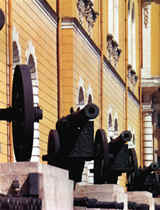|
|
The Arsenal building stands in the West part of Kremlin, between Trinity and Nikolsky Towers. Its construction began in 1702. Its general plan was devised by Peter I, himself. The construction was entrusted to the architects M. Choglokov, M. Remezov, D. Ivanov and C. Konrad. However, it was protracted for many decades. In1706, the work was interrupted by the war with Sweden. It was resumed in 1722 and completed only in 1736. This date is inscribed on the frame of its gates.
A year later, during big fire, Arsenal was destroyed. The engineer L. I. Gerard, under the supervision of the architect M.F. Kazakov, restored it. In 1812, the building suffered from an explosion during Napoleonic army retreat from Moscow. The architects A.N. Bakarev, I.L. Mironovsky, I.T. Tamansky and E.D. Tyurin completed its restoration, in 1828.
Arsenal building, trapeze-form in plan view, with large inner courtyard and two communicating arches, was built of brick and decorated in white stone. It is 24m high.
Originally, arms and ammunition were kept in the Arsenal. The most valuable military trophies were supposed to be collected here. Later on it was decided that a museum of the 1812 Patriotic War should be here. 749 cannons were placed along its Southeast façade, most of which were captured by Russian Army and partisans during Napoleon’s army retreat in 1812. The cannons’ barrels were cast of bronze in Paris, Lyons, Breslau and other European towns from 1790 to 1810. Particularly remarkable are 20 Russian cannons made by the outstanding Russian gunsmiths Andrei Chokhov (“Troil” cannon, 1590), Martyn Osypov (“Gamayun”, 1690), and Yakov Dubinin (“Wolf”, 1659).
On the Arsenal's South façade, at the entrance arch, a plaque was mounted in memory of the soldiers, who were shot by the cadets on October 28, 1917 during a mutiny. Second memorial plaque was mounted in 1965 to commemorate the heroism of the soldiers of Kremlin garrison who perished defending Moscow and Kremlin from Nazi air raids during the Great Patriotic War of 1941-45.
Extensive restoration work was carried out in the Arsenal in 1970-1977. The facades were restored, building constructions and foundations were strengthened, some details of décor were restored and the metal gates were repaired. Russian and French cannons placed along the façade were also restored and elements of their décor, crests and inscriptions were exposed.

|
|

